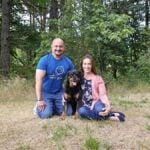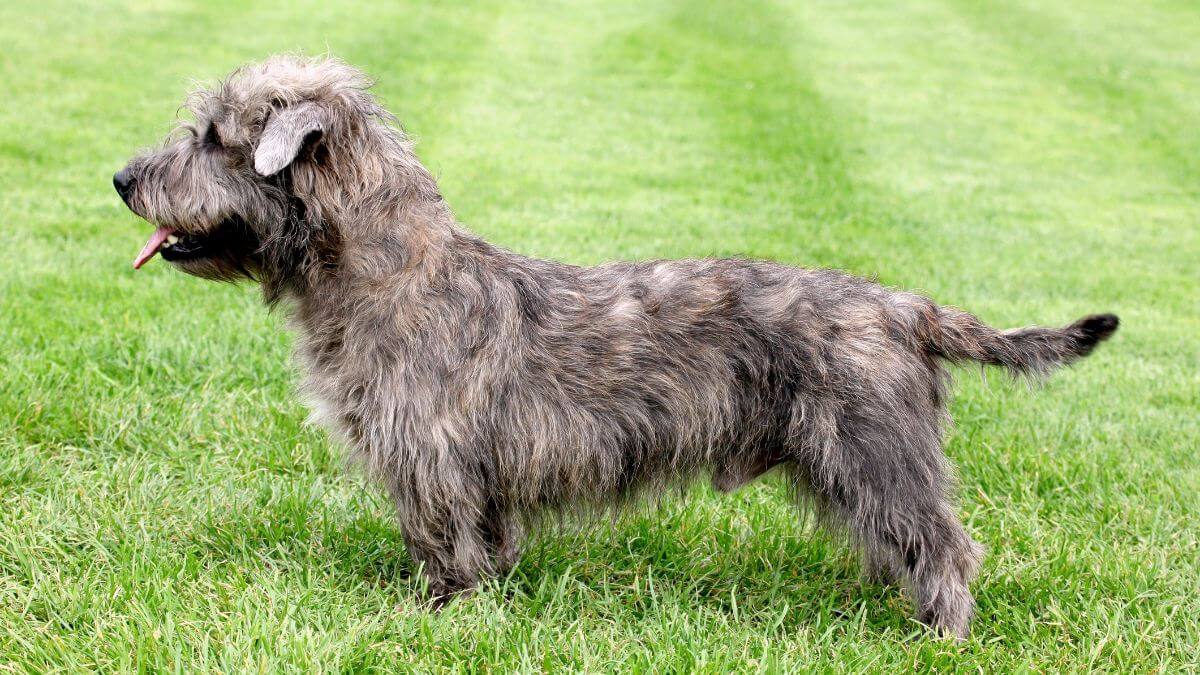


Home » The Glen of Imaal Terrier: A Brief but Action-Packed History

This article was originally published in Showsight Magazine, December 2010 issue.
The name of our breed is a good launching point for a discussion of the history of the Glen of Imaal Terrier. The breed is named after a valley in the Wicklow Mountains, which dominate the northern region of County Wicklow, Ireland. County Wicklow itself is situated on Ireland’s east coast, south of Dublin. It is Ireland’s least populated county, and the Wicklow Mountains are Ireland’s most remote region. Smack dab in the center of this hard-to-reach place is a lovely valley, the Glen of Imaal.
This bit of geography speaks to a great extent about why our breed is, and has been, so little known and has come down to us unrefined by fashion—geographic isolation is very much a factor in the development and history of the Glen. And while we’re on the subject of our breed’s name, let me add that we are quickly becoming the most misspelled AKC breed. There’s one ‘n’ in Glen, double ‘a’ and a single ‘l’ in Imaal. They usually get ‘of’ right. Usually…not always.
Most terrier enthusiasts know that the historical trail regarding the development of all terrier breeds tends to evaporate in the early 19th century—about 1820 or so. We are fortunate in our breed, largely because of the specificity of its place of origin, to know quite a bit about how this unique creature came about.
In the late 16th century—around 1570—England’s Queen Elizabeth I faced what most every British monarch has faced—an Irish rebellion. She had several problems in addressing it. She had no standing army and no funds to pay mercenary soldiers. But she was clever. She struck a deal with Flemish and Lowland mercenaries to go to Ireland to deal with the rebels, offering them tracts of Irish land as payment.
Now, she was no fool, and a bit stingy to boot, so the land she gave them was none too good. In fact, it was fairly lousy. These were tracts of land in the largely barren mountains of County Wicklow. Among those tracts was one jewel: the Glen of Imaal. The soldiers did Elizabeth’s bidding effectively and happily accepted their payment since none of them were landowners, and even this barren land was more than they had to begin with. Finding the one place they deemed habitable, they proceeded to settle the Glen of Imaal and its environs.
We know from several sources that they brought with them their dogs, and among them was a low-slung, harsh-coated hound that looked not unlike today’s PBGV or Basset Fauve de Bretagne. These dogs, in turn, mingled with native Irish types—hounds and emerging terrier types—and over time, these settlers began to develop a race of terrier. These dogs performed traditional terrier tasks such as ridding the house and larder of vermin and hunting fox and badger.
Tradition holds that these dogs were also bred to perform a most unique task: turnspit dogs. A turnspit was a large wheel hung from the ceiling, connected to a pulley system that turned a rotisserie-like device over the hearth. When the dog paddled inside the wheel, it turned the spit, cooking dinner over the fire.
There is no question that turnspits and turnspit dogs were in use throughout the British Isles during this period; however, there are several problems with the theory for Glen dogs. First, meat was a rare luxury in the diet of Irish peasants who owned these dogs. Additionally, the turnspit device was too large to fit in the traditional Irish cottage of the day.
However, in every myth or legend, there is a kernel of truth. Further research reveals the common usage of a smaller, canine-propelled treadmill contraption that powered a butter churn. This scenario is far more plausible, as dairy products were a staple in the diet of Irish peasants. Regardless of the details, the Glen may be unique among dogs in helping prepare family meals.
For centuries, these unique dogs performed their tasks in this quiet, distant corner of Ireland, largely unknown to the rest of Ireland, let alone the world.
In the late 1800s, something happened that changed all of our lives—the first dog show in England. Within a decade, Ireland held its first dog show. For the first time, there was a class for Irish terriers (lowercase “t”), which included early forms of all Irish Terrier breeds.
One account from Lisburn in 1870 described the winning dog, Stinger, as “not high on leg, longer than tall, not straight in front, turned-out feet, and a slatey-brindle color.” This description fits the Glen, and Stinger’s name is preserved in history.
In 1934, the Glen of Imaal Terrier Club of Ireland was formed, and the breed achieved Irish Kennel Club recognition. However, World War II nearly drove the breed to extinction, with fewer than a dozen Glens left in Ireland by war’s end. A revival began in the UK during the 1950s and 1960s, reseeding stock in Ireland.
The breed received full status in England in 1980 and in the US in 2004. It has survived two near-extinctions and remains unaltered by fashion. Glen breeders and fanciers are determined to keep them that way, and judges play a vital role in preserving the breed’s authenticity.
The antique features—those hallmark traits once common to many early terrier types—include a head that seems almost too large for its sturdy body, a matched pair of rose or half-prick ears, slightly bowed front legs with a similarly slight turnout at the pasterns, and a longer-than-tall body profile with a slight rise to the rear.
Two numbers resonate throughout the Standard: three and five. These are often referred to as the “magic numbers” for the breed. The muzzle-to-skull ratio and height-to-length ratios are 3:5, and the approximate weight is 35 pounds.
Glens should have a strong head with a round, medium-sized dark eye. Light eyes are objectionable. The skull should appear almost square when viewed from above, with a pronounced stop. The foreface should have good fill under the eye and taper slightly toward the muzzle, which should have a black nose. The teeth are big with full dentition and a preferred scissors bite, although level bites are acceptable. The ratio of muzzle to skull is 3:5.
Ears are small for the head and are rose or half-pricked. Full drop or full prick ears are to be faulted, as is a “mismatched pair”—one rose and one drop ear or one half-prick and one drop ear.
The topline is of particular importance and distinct to the breed’s history. It is straight (not level) with a strongly muscled loin and a slight rise to the highly set half-docked tail or natural tail. This rise should be slight. Dogs with an extreme rise in the topline are often straight in the stifle or excessively bowed in the front legs. Regardless of length, the tail should be carried in the 12 to two o’clock position. There should not be a drop-off at the croup.
The rising topline served a function in working Glens, providing leverage for pulling large vermin from dens and for walking the wheel or treadmill that drove a turnspit or churn.
The ratio of height (withers to ground) to the length of the body (point of chest to point of hip) is 3:5. The maximum height is 14 inches, and the minimum is 12.5 inches. Though this is a range of only 1.5 inches in height, given that the breed is 40% longer than tall, this can mean upwards of 2.5 inches difference in length. Add to that the third dimension of substance, and you have a substantial range between the smallest and largest Glens. There is no preference for size, and overall balance must always take precedence over any particular number.
Glens should have well-laid-back shoulders leading to strong, short, bowed front legs. The forearm curves around the rib cage, and the elbows are tight. The feet turn out slightly from the pasterns only. Correct Glens have enough forechest and keel to prevent fiddle-fronts.
The hindquarters of a Glen are impressive. They are well-boned and muscled, with a well-defined second thigh and good bend of stifle. They should never be soft or flabby, as they are the driving forces of the dog.
The Glen is the only one of the four terrier breeds of Ireland that is not defined by color. They come in an array of colors within the Wheaten, Blue, or Brindle ranges. There is no preference for color or depth of color. Regardless of color, the coat is harsh—not wire—with a soft undercoat. It is kept at a medium length of approximately 1.5 inches over the body and longer on the head and furnishings. The hair of the furnishings is generally softer than the shorter body hair and is often lighter in shade.
The Glen should give the appearance of a rough-and-ready working terrier and should never be overtrimmed. The coat is hand-stripped and never scissored. It may be neatened by hand but should never be sculpted.
You may be surprised at how freely a Glen can move. They cover ground well with good reach and drive. They are clean coming and going, without paddling of forefeet, and carry their tail gaily. Move them on a loose lead, allowing room between dogs.
Sparring is not encouraged. While Glens are generally gentle and docile, they can be exceptionally game when called upon. Their short, stocky bodies can be difficult to control if focused on a challenge. Aggression in the ring should never be tolerated.
Any departure from the Standard is considered a fault, and the seriousness of the fault is in proportion to the degree of departure.